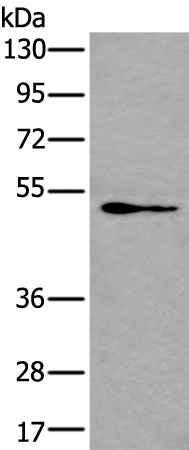
| WB | 咨询技术 | Human,Mouse,Rat |
| IF | 咨询技术 | Human,Mouse,Rat |
| IHC | 咨询技术 | Human,Mouse,Rat |
| ICC | 技术咨询 | Human,Mouse,Rat |
| FCM | 咨询技术 | Human,Mouse,Rat |
| Elisa | 1/5000-1/10000 | Human,Mouse,Rat |
| Aliases | HDR; HDRS |
| WB Predicted band size | 48 kDa |
| Host/Isotype | Rabbit IgG |
| Antibody Type | Primary antibody |
| Storage | Store at 4°C short term. Aliquot and store at -20°C long term. Avoid freeze/thaw cycles. |
| Species Reactivity | Human, Mouse |
| Immunogen | Synthetic peptide of human GATA3 |
| Formulation | Purified antibody in PBS with 0.05% sodium azide and 50% glycerol. |
+ +
以下是关于GATA3抗体的3篇参考文献及其简要摘要:
1. **文献名称**:*GATA3: A Multispecific But Potentially Useful Marker in Surgical Pathology*
**作者**:Turbin DA, et al.
**摘要**:该文献总结了GATA3抗体在多种肿瘤中的表达模式,强调其在乳腺癌、尿路上皮癌及部分神经内分泌肿瘤中的高特异性,并探讨其在鉴别诊断中的应用价值。
2. **文献名称**:*Utility of GATA3 Immunohistochemistry in Diagnosis of Uncommon Subtypes of Breast Carcinoma*
**作者**:Cimino-Mathews A, et al.
**摘要**:研究评估GATA3抗体在罕见乳腺癌亚型(如三阴性乳腺癌)中的表达,发现其敏感性达80%-90%,支持其作为乳腺上皮分化的可靠标记物。
3. **文献名称**:*GATA3 Expression in Primary and Metastatic Tumors: A Comparative Immunohistochemical Study*
**作者**:Miettinen M, et al.
**摘要**:通过对比原发灶与转移灶肿瘤,研究发现GATA3抗体在转移性乳腺癌中表达稳定,但在其他转移癌(如肾细胞癌)中表达缺失,提示其临床分型意义。
以上研究均聚焦于GATA3抗体在病理诊断中的实用性及局限性,适用于癌症分型与鉴别诊断场景。
GATA3 is a transcription factor belonging to the GATA family, characterized by two conserved zinc finger domains that bind to DNA sequences containing the "GATA" motif. It plays critical roles in cellular differentiation, development, and tissue homeostasis. GATA3 is essential for the maturation of T lymphocytes, directing Th2 cell differentiation, and regulating immune responses. Beyond immunology, it is pivotal in the development of mammary glands, kidneys, and the nervous system.
In cancer research, GATA3 has emerged as a valuable biomarker. It is highly expressed in estrogen receptor (ER)-positive breast carcinomas and urothelial carcinomas, making it a key diagnostic tool in pathology. GATA3 antibodies are widely used in immunohistochemistry (IHC) to identify tumor origin, particularly in metastatic or poorly differentiated cancers. Its nuclear staining pattern aids in distinguishing breast or urothelial malignancies from other carcinomas, such as lung or gastrointestinal tumors.
Clinically, GATA3 expression correlates with favorable prognosis in certain breast cancer subtypes and guides therapeutic strategies. However, its utility extends beyond oncology; GATA3 mutations are linked to HDR syndrome (hypoparathyroidism, sensorineural deafness, and renal dysplasia). Antibodies against GATA3 thus serve dual roles: as diagnostic tools in cancer and research reagents for studying developmental disorders. Their specificity and reliability depend on epitope targets and validation protocols, emphasizing the need for standardized testing in clinical applications.
×